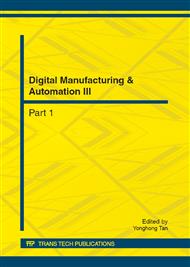p.842
p.847
p.852
p.856
p.860
p.865
p.873
p.880
p.886
Modeling and Simulation of Emulsion Pump Station Pressure Control System Based on Electro-Hydraulic Proportional Relief Valve
Abstract:
The emulsion pump station is the power source of the hydraulic support and the hydraulic props of fully-mechanized mining face. Providing work medium such as high pressure and big flow for the system used liquid such as hydraulic support are its responsibility. This paper put forward a system can control the pressure of the emulsion pump station based on electro-hydraulic proportional relief valve. After applying the electro-hydraulic proportional relief valve technique, this system reconstructed the pipeline of pump station. In order to realize the control of pressure, this system used the PID controller in PLC technique to perform logical operations and finally controlled the unload action of overflow valve. This paper give a detailed design of the system, and then build a mathematical model based on the electro-hydraulic proportional pressure control system hardware and analysis the results of control using simulation software.
Info:
Periodical:
Pages:
860-864
Citation:
Online since:
July 2012
Authors:
Price:
Сopyright:
© 2012 Trans Tech Publications Ltd. All Rights Reserved
Share:
Citation:


